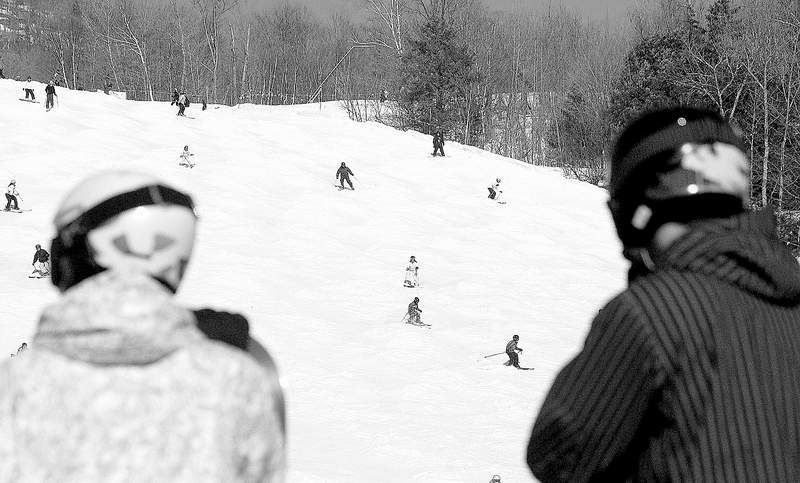Richardson’s death revives debate over ski helmets
Published 5:00 am Friday, March 20, 2009

- Skiers wearing helmets watch others at Mont Tremblant, the resort where Natasha Richardson, above, took a fatal fall.
NEW YORK — News that Natasha Richardson died of head injuries after falling on a ski slope has renewed debate over whether helmets should be mandatory for snowboarders and downhill skiers. The 45-year-old actress was not wearing a helmet when she fell Monday at Mont Tremblant ski resort in Quebec. She died Wednesday in a New York hospital.
Research shows wearing a helmet decreases the likelihood of having a head injury by 40 to 60 percent, said Dr. Robert Williams, associate professor of anesthesia and pediatrics at Fletcher Allen Health Care in Burlington, Vt. “There’s no downside at all to wearing a helmet,” he said.
The National Ski Areas Association is not aware of any states that mandate helmets, but the association and its member resorts promote their use, and a growing number of skiers and snowboarders choose to wear them.
According to the group, nearly half of U.S. skiers and snowboarders wore helmets in the past two years, up from about 25 percent five years earlier. Sales of helmets have grown at a rate of about 9 percent each year since 2005-06, according to SnowSports Industries America.
Quebec officials said Thursday that they are considering making helmets mandatory on ski slopes following Richardson’s accident. Emergency room doctors had been lobbying for the requirement, and her death added impetus to the plans, said Jean-Pascal Bernier, a spokesman for the sports minister.
“By no means will a helmet save you 100 percent, but it’s definitely a step in the right direction to try to prevent brain damage or something like that,” said Valerie Powell of the Canada Safety Council.
But the National Ski Areas Association, based in Lakewood, Colo., stops short of calling for legislation.
The increase in helmet usage has not reduced the overall number of ski fatalities; more than half of the people involved in fatal accidents last season were wearing helmets at the time of the incident, according to information gathered by the group.
And ski and snowboarding-related deaths are relatively rare. During the 2004-05 season, 45 fatalities occurred out of the 56.9 million skier/snowboarder days reported for the season, according to NSAA.
Helmets may be effective at preventing minor injuries, but they have not been shown to reduce fatalities, said Jasper Shealy, a professor emeritus at the Rochester Institute of Technology who has been studying skiing and snowboarding since 1970.
He encourages people to wear helmets, although he suspects they may give people a false sense of security. Helmets work better at slow speeds, he said, when they can protect against injuries caused by collisions with solid objects.
Some ski operators are among the most vocal opponents to mandated helmet use.
Alexis Boyer of the Quebec Ski Areas Association said 90 percent of youngsters younger than 12 already use helmets, but making that law would put operators in the position of having to police their guests, many of whom come from outside the province and country and may not be aware of the requirements.
Still, people tend to change their behaviors as a result of high-profile deaths.
Andrea Fereshteh, 29, a writer at Duke University, said she started wearing a helmet after the ski-related deaths of Sonny Bono and Michael Kennedy. Both crashed into trees.
“It just became much more publicized about the need for helmets,” she said.
Richardson’s death is likely to hit home for skiers because she was on a beginner slope when she fell.
‘Talk and die’ syndrome
In “talk and die” syndrome, people can have what seems to be a mild blow to the head, appear perfectly lucid and then within hours lapse into a coma — which is what reportedly happened to actress Natasha Richardson after she fell on a Canadian ski slope Monday.
“It is not a very common occurrence,” said Dr. Steven Flanagan, medical director of the Rusk Institute of Rehabilitation Medicine at New York University Langone Medical Center. “A patient comes into the emergency room talking and then rapidly deteriorates” as blood pools and puts pressure on brain tissue.
Flanagan and other doctors speculated that Richardson could have had an epidural hematoma, usually caused by a trauma such as a fall, in which blood builds up between the cover of the brain, called the dura, and the skull.
A CT scan is the best way to diagnose a brain injury, doctors say, and anyone who has had a blow to the head should be watched for changes in his or her condition.
Source: Newsday






